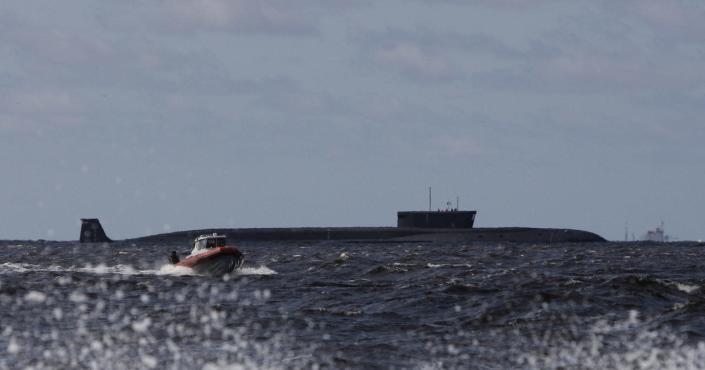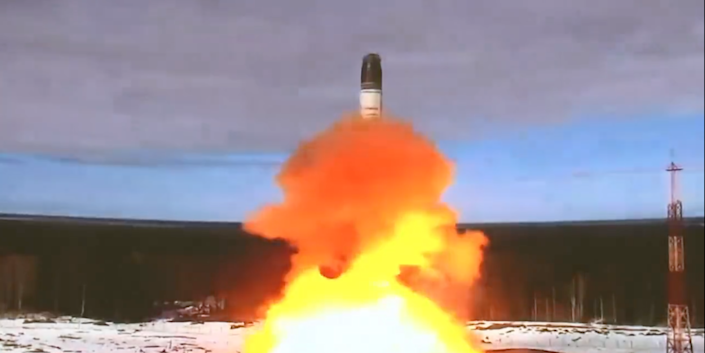
Russia has tested the world’s largest and heaviest nuclear missile, the RS-28 Sarmat intercontinental ballistic missile (ICBM). The missile, which lifted off from northern Russia last week, weighs 458,000 pounds, or as much as 11 F-22A Raptor fighters. Sarmat can deliver up to ten thermonuclear warheads and has the range to strike anywhere on Earth. But as powerful as it is, the missile has distinct trade-offs that could make it less impressive than it sounds.
????????Today at 15:12 Moscow time, Sarmat, land-based intercontinental ballistic missile, was successfully launched from a silo at the Plesetsk state testing cosmodrome in Arkhangelsk Region. pic.twitter.com/xLsAUIDdIX
— Минобороны России (@mod_russia) April 20, 2022
The Sarmat missile lifted off on April 20 from Russia’s Plesetsk Cosmodrome and delivered a warhead onto a target 500 miles away on the Kamchatka Peninsula. Russia’s TASS news agency, one of several government-controlled media outlets, quoted the country’s Ministry of Defense, stating:
“The launch’s tasks were achieved in full. The designated characteristics were confirmed at all the stages of its flight. The practice warheads arrived at the designated area at the Kura proving ground on the Kamchatka Peninsula.
“The new missile is capable of striking targets at long ranges, using different flight paths. The Sarmat features unique characteristics that enable it to reliably breach any existing and future anti-ballistic missile defenses.” (The Ministry of Defense website is currently offline to visitors from the United States.)
TASS described Sarmat as “cutting-edge,” “powerful,” and a “breakthrough” weapon that will replace the Voyevoda ICBM (known to NATO as the SS-18 “Satan”) starting later this year.
Here’s another perspective of the launch:
???????? Successful launch of Sarmat intercontinental ballistic missile was held today at Plesetsk Cosmodrome from a silo launcher.
???????? Here is HD footage. pic.twitter.com/lzmygsolp8
— Минобороны России (@mod_russia) April 20, 2022
Sarmat is simply a large ICBM, the largest ICBM anyone has ever bothered to build. The three-stage, solid-fuel missile is 115 feet long and 9.8 feet wide with a total, fueled weight of 458,000 pounds. The missile can boost up to ten tons into low-Earth orbit, including, “Ten large warheads, 16 smaller ones, a combination of warheads and countermeasures, or hypersonic boost-glide vehicles.”
Why is Sarmat so big? Russian President Vladimir Putin has warned the U.S. several times that its missile defense capabilities put Russia’s nuclear arsenal at risk. Under the policy of Assured Destruction, the United States and Russia—and indeed all the nuclear powers—intrinsically hold each other hostage to a counterattack, or “second strike,” with no one side able to attack the other with nuclear weapons without risking being attacked in return. If one side with missile defenses, such as the United States, is able to defend itself from nuclear attack, other potential adversaries might feel less secure, worrying that the U.S. could launch a surprise attack and defend itself from the inevitable second strike.
The U.S. does have limited missile defenses in the form of the Ground-Based Interceptor, designed to protect the nation from a limited attack from rogue countries such as North Korea. But the system has less than 50 missiles and could credibly defeat an incoming attack of ten missiles or less at best. For countries like China and Russia, each with hundreds of missiles, that’s not a problem … yet. However, both countries have expressed concerns that the U.S. missile defense system could be scaled upward to handle many more incoming missiles.
Here’s a 2019 Ground-Based Interceptor test that involved intercepting an ICBM-like target:
[embedded content]
Sarmat will be able to launch up to ten large warheads at once, and in turn present enemy missile defenses with ten warheads to deal with at once. The idea is that even if the defender has enough interceptor missiles to go around, missiles like Sarmat can overwhelm the defender’s ability to shoot down threatening missiles at a specific moment, allowing at least some to slip through. Sarmat’s long range, up to 11,184 miles, also means planners could get creative with how the warheads approach their targets, perhaps going around local defenses.
Sarmat’s huge capacity is a double-edged sword. If the missile encounters a mechanical problem and fails to launch, that’s ten nuclear weapons stranded in Russia and a large hole in Moscow’s targeting plan. Russia’s ability to use Sarmat will also be constrained by the New START arms control treaty, which limits both the U.S. and Russia to 800 missile launchers or bombers and 1,550 deployed warheads.
Just 150 Sarmat missiles, each maxed out with warheads, could carry almost all of Russia’s allowable nukes, leaving just 50 for the rest of Moscow’s nuclear triad, including mobile ICBMs such as the truck-mounted Topol-M, Borei-class missile submarines, and strategic heavy bombers. The constraints of New START make it likely Russia will build only a limited number of Sarmats in order to beat down U.S. missile defenses, giving the rest of Moscow’s nuclear forces a freer hand.


Is all this necessary? The U.S. has no stated intention of boosting the number of missile interceptors in its arsenal, and even if it wanted to, doing so could be astronomically expensive. For now, Russia’s nuclear deterrent is secure, but as far as Moscow is concerned, it’s better to be safe than sorry.
The war in Ukraine will also make Sarmat more useful, though more as a political tool than a military tool. Russia’s military is also taking a beating in Ukraine, and its conventional forces will take years to rebuild. In the early 1990s, a period of severe economic turmoil in Russia, nukes were the only credible defense Moscow had. That time is likely coming again, worsened by wartime economic sanctions imposed by the West. Being able to boast about having the largest missiles in the world, whether that matters or not, will be the kind of chest-puffing that keeps enemies at bay.
That is, if Moscow can afford it.
You Might Also Like




